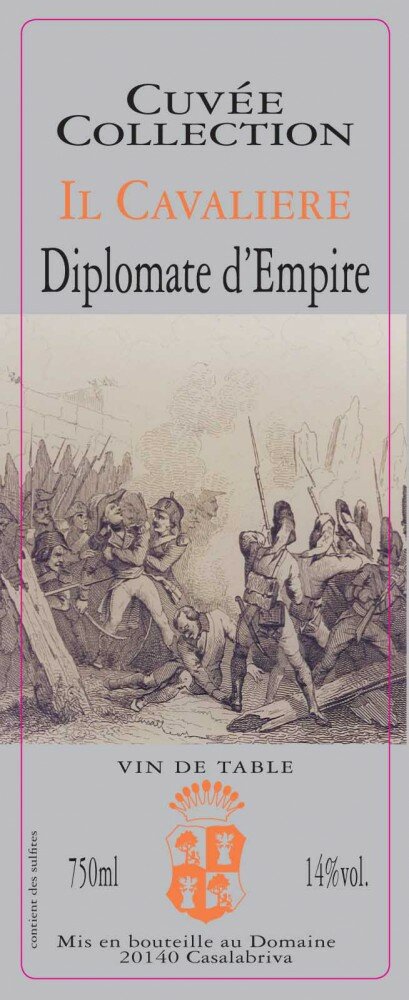 During dinner with some friends on my patio last night, I opened a bottle of Corsican wine about which I knew next to nothing. It really illustrates one of the things I love about wine, which is that there’s always something new to learn. Whether it be a comparative tasting of different vintages or chemistry or culture or tracing the lineages of grapes, the dive into a wine’s origins can be an absolutely endless journey.
During dinner with some friends on my patio last night, I opened a bottle of Corsican wine about which I knew next to nothing. It really illustrates one of the things I love about wine, which is that there’s always something new to learn. Whether it be a comparative tasting of different vintages or chemistry or culture or tracing the lineages of grapes, the dive into a wine’s origins can be an absolutely endless journey.
Cuvée Collection “Diplomate d’Empire, Il Cavalière” from Domaine Abbatucci not only occupied a portion of the conversation last night, it has occupied my entire morning. Composed of 37% Vermentinu, 20% Rossala Bianca, 19% Biancu Gentile, 14% Genovese, and 10% Brustiano (from the Kermit Lynch website), the cepage was so foreign to me that I’ve been obsessing about figuring out what the hell all of these grapes actually are.
The wine itself was remarkably dense and rich: Very floral, fleshy nose with melon/white fruit aromas. Sweet on the palate, but not flabby at all. I tasted the fruit first and foremost, but there’s an inherent mineral-driven acidity/structure to it. Viscous and oily texture, it’s got a very serious weight to it and a finish that lingers. It’s really very interesting, luscious stuff. Very distinct and dare I even say unique. I wish I’d gotten a second bottle, because for all of its loveliness, I felt like it had more to offer had I given it a bit more time to breathe.
After having my mind blown, I decided to investigate the winery and those odd grapes a bit.
First, the winemaker has a fascinating history. His father is responsible for saving tons of native Corsican grapes, and they’re directly descended from Napoleon Bonaparte. This Cuvée Collection set of wines are all named after people who were involved in Napoleon’s life: So the Diplomate in question is actually a childhood friend of Napoleon who fought with him at the Battle of Waterloo. The details are outlined on Lynch’s website.
The grapes are equally interesting. Having compared the importer’s notes and the Domaine’s own website, I realized that while Lynch was listing the Corsican names for the grapes, they’re far more commonly known by their Italian names (or the synonymous French names). Vermantinu was obviously Vermantino, prized for its aromatic qualities. Rossala Bianca is, in Italy, Rossola Bianca, and according to a book by Oz Clarke, it’s synonymous with Ugni Blanc from France, most notable for its use in making cognac (where grapes that yield high acid are prized for the flavors it yields through distillation). Of course, Ugni Blanc is also, I believe, know as Trebbiano in Italy. Say what?
So the morning got off to a start that was, to put it bluntly, confusing as fuck.
I kept digging, though, and I could find nothing on Bianco Gentile except some references to other Corsican wines where it was consistently referred to as one of the “lost” varieties that’s recently been reclaimed. As I mentioned earlier, it’s the Abbatucci winemaker’s father who took it upon himself to wander the Corsican countryside and preserve grapes like Bianco Gentile from what would have otherwise been extinction in the 1960s.
I couldn’t find much on Genovese other than some references to a “Bianchetta Genovese,” which is ostensibly a non-descript Italian grape called Albarola according to Wikipedia and a few blogs. The subtle distinctions aren’t really all that important, I suppose, but while it’s known for its plantings in northern Italy, this Albarola simply must be at least a little different in Corsica (assuming its even related). The evolution of distinct ecosystems and how that impacts the resulting grapes is every bit as interesting to me as the food and cultural components to how a particular wine has evolved over time.
Similarly, do a Google search on the last grape, Brustiano, and about a million websites will tell you that it’s synonymous with Vermantino, but clearly the winemaker finds something different since he lists both Vermantino and Brustiano as components to his wine.
Regardless, this combination of mostly soft, semi-sweet grapes and Ugni Blanc created a drink that’s quite profound. Naturally, it’s available in limited quantities. The winemaker makes a number of wines, but the “Cuvée Collection” series are all from a single plot of these heirloom, indigenous grape varieties, farmed biodynamically (down to the weird ass moon cycle rituals) with low yields, and so on.
So its rarity and relatively lofty price tag are easy to understand.
This bottle was recommended to me by Elie Boudt at Elie Wine Company in Royal Oak. There are only two cases, so if you’re interested, get there soon. I drank it along side grilled halibut and veggies as well as a wheat berry salad with a distinctly provençal twist. Pretty much perfect.




















